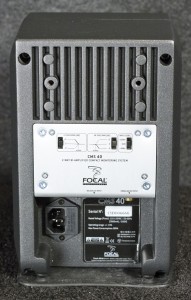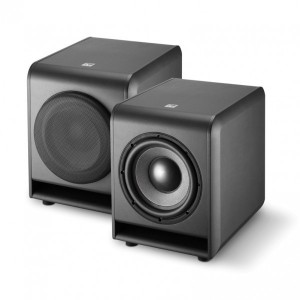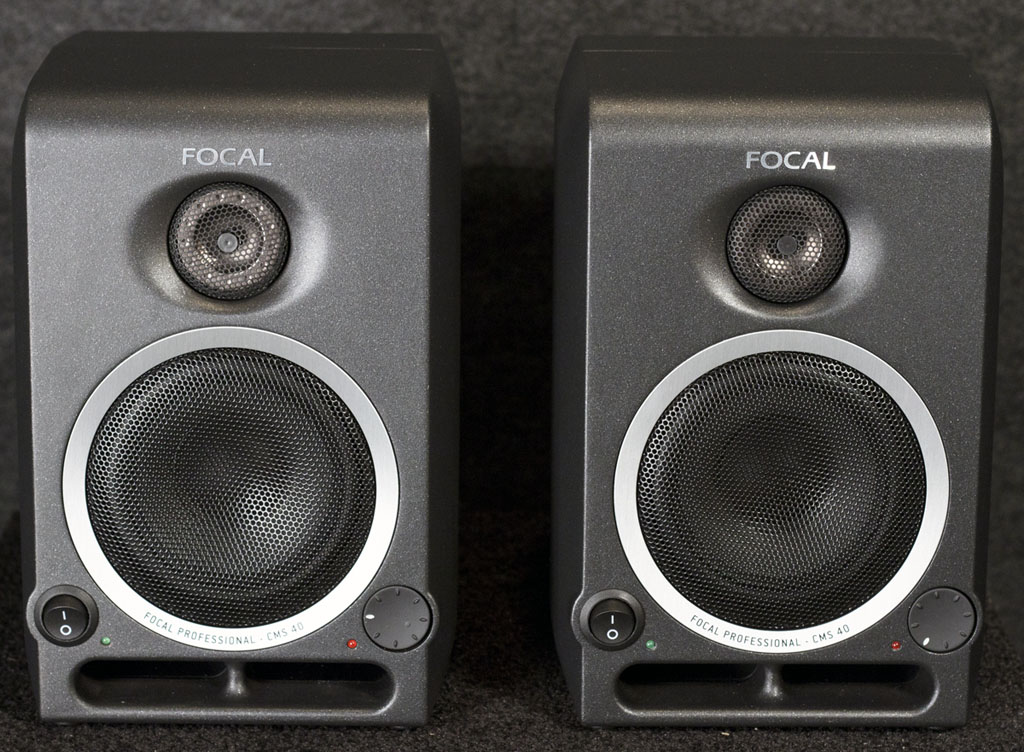Hooray for the little guys: Though they are small in stature, the Focal CMS 40 near-field studio monitors — along with the accompanying not-so-small Focal CMS Subwoofer — pack a one-two wallop of clarity and affordability. The CMS 40 is the little brother to the increasingly admired CMS 50 and CMS 65 (both of which also pair up with the CMS Sub) but whatever you do, don’t discount the CMS 40 as a tiny, unwanted tagalong.
For those of you not in the know, Focal (pronounced fo-kal) was founded in 1979 in Saint-Etienne, France by Jacques Mahul. Mainly known for audiophile speakers and speaker components throughout the ‘80s and ‘90s, in the late ‘90s Focal moved into high-end car audio systems and even manufactured speaker and driver assemblies for pro audio companies (such as KRK for its very popular 6000, 7000 and 9000 series of monitors before the company was sold and then turned to China for parts).
Focal CMS 40 Features
The solidly constructed CMS 40 weighs in at a hefty 11 lbs: pretty stout for something measuring only 9 3/8 x 6 1/8 x 6 1/8 inches. Packed inside its reinforced, shielded and dampened die-castaluminum speaker enclosures are two 25W, class A/B amplifiers (yes, these little puppies are biamplified); Focal’s hallmark aluminum/magnesium inverted dome tweeter; and a 4-inch driver featuring Focal’s polyglass cone design. The CMS 40 has an elegant, yet lean and mean look due to its black powdered paint finish.
 Another user-friendly feature (atypical for many small monitors) is the on/off switch and recessed volume knob on the front, not the rear. Also on the rear panel are two inputs: balanced female XLR and unbalanced RCA. Alongside the inputs are HF (4.5 kHz to 20 kHz) and LF (<450 Hz) shelving switches, just adjacent to the three-way input sensitivity switch (+4 dBu, 0, -10 dBv).
Another user-friendly feature (atypical for many small monitors) is the on/off switch and recessed volume knob on the front, not the rear. Also on the rear panel are two inputs: balanced female XLR and unbalanced RCA. Alongside the inputs are HF (4.5 kHz to 20 kHz) and LF (<450 Hz) shelving switches, just adjacent to the three-way input sensitivity switch (+4 dBu, 0, -10 dBv).
Four threaded, recessed fix points are included on the bottom of the CMS 40, fully compatible with many K&M and Omnimount mounting kits (allowing use with standard mic stands and many wall mounts). Of course, you can also just set them on a desk top or meter bridge with the included four rubber feet or rubber decoupling mat; the monitors will not sit level without them.
The CMS 40 comes with a pre-installed woofer grille and a little tool to help remove it, plus tweeter phase plugs. Due to the fact that the CMS 40 manual is vague on the subject of the phase plugs, I contacted Simon Côté, North American sales and production manager for Focal, for more information. He explained that these little jewels are mechanical EQ/phase-correction devices for keeping the high-frequency dispersion correct when the speaker grilles are removed. Upon further inspection of the grilles, I noticed that there is a little EQ/phase-dispersion dot right in the middle of the smaller grille.
 After unpacking the CMS Subwoofer, I was impressed with its size and weight: just over 50 lbs. and measuring 17.1 x 14.4 x 17.3 inches. Its rear panel boasts all of the accoutrements that professional subs should have: all balanced XLR I/O; 0 to 180 degree phase adjustment; -24 to +24 dB level control; variable 50 to 150 Hz low-pass frequency adjust; polarity flip and mute switches; and remote on/off foot switch input (a Boss FS-5L foot switch with a regular unbalanced instrument cable worked for me). The heart of the sub is Focal’s own high-excursion 11-inch polyglass cone design drive unit powered by a 300W amp, governed by Focal’s adoption of BASH technology. (Read this for more on how BASH works.) The CMS Sub is finished with a neutral grey vinyl coating, and the rear panel is finished in silver with black writing (easy to read in low light situations). I liked the fact that the Sub has four 1-inch feet on the bottom that lift it off the floor.
After unpacking the CMS Subwoofer, I was impressed with its size and weight: just over 50 lbs. and measuring 17.1 x 14.4 x 17.3 inches. Its rear panel boasts all of the accoutrements that professional subs should have: all balanced XLR I/O; 0 to 180 degree phase adjustment; -24 to +24 dB level control; variable 50 to 150 Hz low-pass frequency adjust; polarity flip and mute switches; and remote on/off foot switch input (a Boss FS-5L foot switch with a regular unbalanced instrument cable worked for me). The heart of the sub is Focal’s own high-excursion 11-inch polyglass cone design drive unit powered by a 300W amp, governed by Focal’s adoption of BASH technology. (Read this for more on how BASH works.) The CMS Sub is finished with a neutral grey vinyl coating, and the rear panel is finished in silver with black writing (easy to read in low light situations). I liked the fact that the Sub has four 1-inch feet on the bottom that lift it off the floor.
CMS 40 In Use
Encouraged by the unbalanced RCA inputs on the CMS 40 monitors, I pulled up my iTunes library on my laptop and just went straight from its headphone output, and voila! — it worked great. Next, I hooked them up from the monitor matrix on my Dangerous Music D-Box, first to the balanced XLR inputs of CMS Subwoofer, then XLR out from the sub to the XLR inputs of the CMS 40. I set the CMS 40 pair beside my main monitors on the monitor bridge of my Omnirax Force 24 desk, approximately 38 inches apart and pointed in towards my listening position at about a 30-degree angle.
After about an hour of trying different combinations of the frequency shelving switches; listening with the grilles on and off; auditioning sub adjustments; and even listening without the Tweeter Phase Rings in place (which I don’t recommend, as it tends to leave your stereo field unfocused and scattered), I eventually settled on what sounded like the flattest response in my particular setup.
At first, the CMS 40 pair seemed a bit on the bright side, even with the shelving set to flat. I then remembered my conversation with Simon: He informed me that they have a break-in period of about 20 hours. Sure enough, after using them on just a few mixing sessions, the high end seemed to tame itself nicely, and I began to settle right in with them. I finally ended up setting the CMS Sub to almost the same settings (EQ and level) of my KRK 10s; overall, it was nearly identical in sound and feel, but the CMS Sub definitely has more horsepower when it needs it. The CMS Sub also has a tighter yet more transparent “enveloping” feel to it. Even though the CMS Sub frequency select only goes up to 150 Hz, it has a frequency response of up to 250 Hz, which works out well when pairing with smaller monitors.
Over a four-week period, everything that I worked on with the CMS setup translated very well to the outside world, commonly known as the “real world” (car stereos, cheap computer speakers, jam boxes, clients, etc.). I found myself leaning on the CMS rig — rather than my mains and other monitoring sources — when bringing in effects like reverb and delay. I also found them to be extremely reliable when EQ-ing and compressing vocals. I took them to the commercial studio where I work a lot and used them alongside their Genelec 1030A pair — bigger than the CMS 40s, but in the similar vein of small, near-field type speakers — and the CMS 40s performed admirably.
The gripes I have about the CMS 40 are few. Their little rubber feet seemed to wear out quickly and don’t want to stay in the fixing point holes when you need to move them. Also, they aren’t rated to get much louder than 97 dB SPL (peak @ 1m). But in fairness, smaller near-field monitors are made for critical listening at low to medium volumes; if I want something to get any louder than that without running out of power on me, that’s what the big mains are for.
Summary
The Focal CMS 40 monitors with the CMS Sub would fit into any audio production situation, whether for music production, audiofor- broadcast and video, as well as a high-quality solution for the blossoming market of the top-end home studio. The CMS 40 is small, well-built, simple to use, and affordable considering their high-end performance. But most importantly, they are accurate performers, translating very well to the real world. I found that if my mixes sound good on this monitor set up, they will sound great everywhere else.
Sterling Winfield is a Texas-based producer, engineer and mixer with gold and platinum credits for artists such as Pantera, Damageplan and HELLYEAH.
